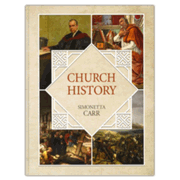Simonetta Carr’s Church History offers one of the few options for studying church history that is appropriate for children from about fifth grade and up. It should be most appropriate for high school students.
It is written from a Reformed Protestant point of view, so it will be problematic for Catholics, and possibly even for some other churches that differ from Reformed theology. With those caveats in mind, Carr does a much better job than I’ve seen in most Protestant church histories for students below college level. While many others jump from the early church to the Reformation, as if nothing significant happened for more than a millennium, Carr devotes four of her nine chapters to eras up through 1517, when Martin Luther sparked the Reformation. For example, students learn about many of the church fathers and others important to the Christian church in both its eastern and western expressions. They learn about the Carolingian Renaissance in the eighth century, within which the classical form of education took shape (with the trivium and quadrivium as the curriculum). In addition, she addresses the issues of Bible translations forthrightly, acknowledging that the Catholic Church allowed some translations into vernacular languages but was often concerned about the accuracy of translations.
“Think About It” call-out boxes occasionally present a few questions for students to answer, research, or discuss. These questions often address thorny issues, such as, “Created or uncreated, same substance or similar substance…does it really matter? Can’t we just love Jesus without understanding who He really is? Why not?” (p. 17). As you can tell from the “Why not?" question following the initial one, these questions often contain a bias or prompt a certain response. Even so, they are worth pondering, although you might save deep questions like these for at least junior high. There is no answer key because these questions are open for students to express their own opinions and thoughts.
Church History helps students form their worldview through discussion of foundational Christian beliefs, competing beliefs, and apologetic arguments, so you might incorporate it within a worldview curriculum.
Some questions require some maturity to form an opinion. A good example is one on page 158:
Some portions of the Bible have been misinterpreted in different ways. Even teachers who were later considered heretics thought they were following the Bible. Since this is a danger, is it safer for Christians to say they have no creed but the Bible or to compare their interpretations with the ones that have been accepted by many Christians before them. Explain your answer.
Students attending a Bible-only, non-denominational church might find such questions troubling, perhaps causing them to question their own church’s teaching. In several places, Carr discusses at length the divisions within the Protestant world. But rather than leave students confused, she includes a list of the five essential teachings—the fundamentals—that were decided upon by a group of Christians who met in Ontario, Canada at the end of the nineteenth century. In general, Carr’s view seems to be that Christians should agree on the fundamentals, and beyond that, they should study and consider contrary ideas about their faith, trusting that the fundamental beliefs can withstand all challenges. Even so, I recommend that parents read and discuss problematic topics with their children.
The last two chapters address the modern era, covering topics such as the rise of Darwinian ideas, missionary efforts, and church development around the world. She includes the persecution and martyrdom of Christians, such as in Vietnam through the 1800s, during the Bolshevik revolution in Russia and in South America in the twentieth century, and in China up to the present.
The study of church history is necessarily presented within the context of world history, and Carr assumes that her readers have some familiarity with it. For instance, the first chapter summarizes major events in the formation of the church on a timeline, then begins the actual text with a discussion of persecutions under the Romans. Students should already know about the Roman Empire to understand the context. Timelines at the beginning of each of the nine chapters are very helpful for recalling relationships between events.
Carr includes more detail on some topics than one would expect for an audience below college level. For instance, she has a two-page discussion about the First and Second Dutch Secessions. And sometimes she moves very quickly through topics that might have been saved for older audiences, such as on page 132 where she takes on the problem of pain and suffering through the thoughts of the philosophers Voltaire, Kant, and Rousseau. A lengthy series of “Think about It” questions on the next page challenges students to think deeply about these philosophers’ ideas, but I imagine that some students won’t be ready for this level of thought.
The book itself is of very high quality, with a hardcover, glossy pages, and full-color illustrations. It includes both a glossary and an index.
Summary
While Church History is written from a Reformed Protestant point of view, it includes critical information regarding developments related to other Christian denominations rather than ignoring them. It also addresses larger, worldview issues that affect all Christians.










